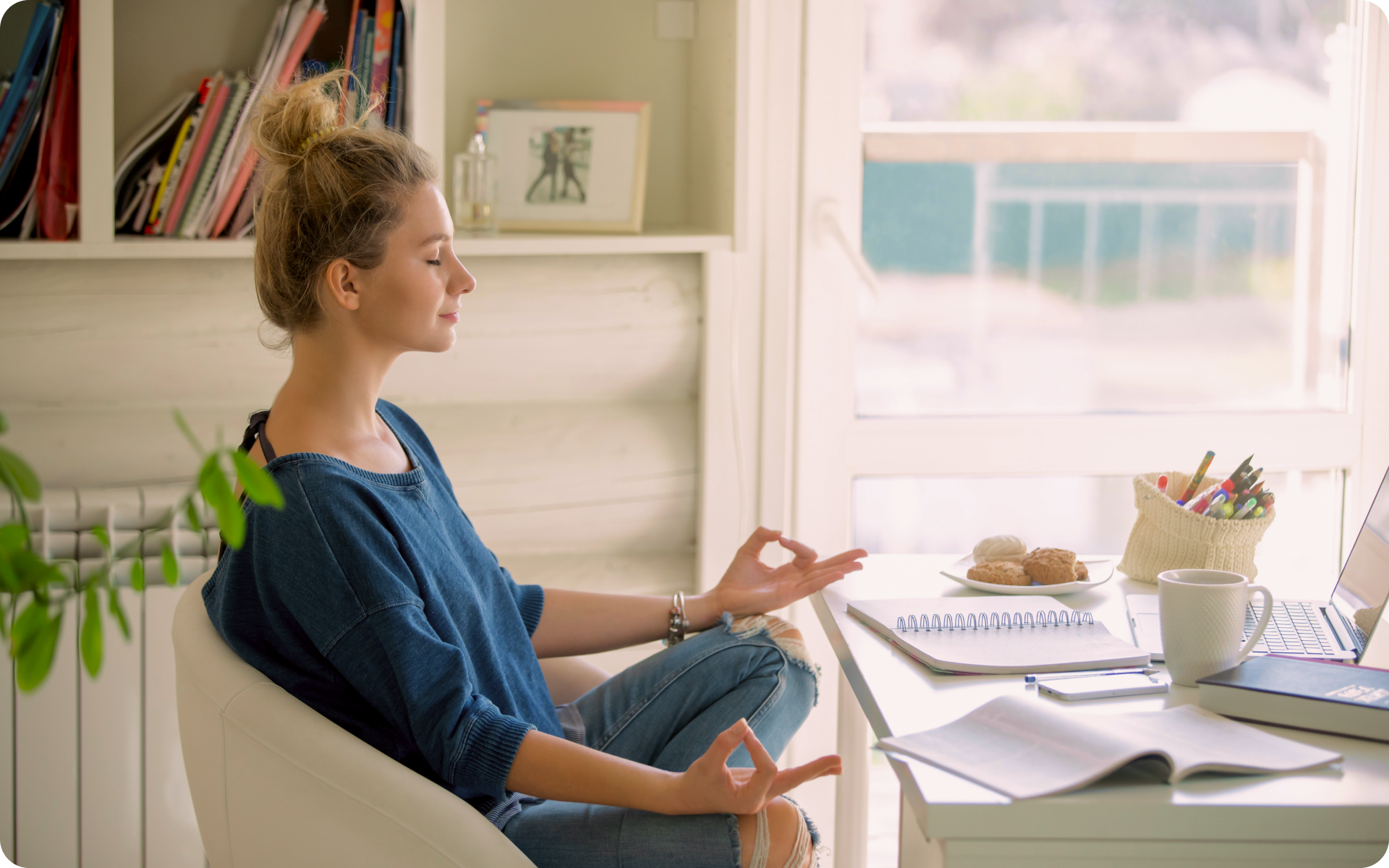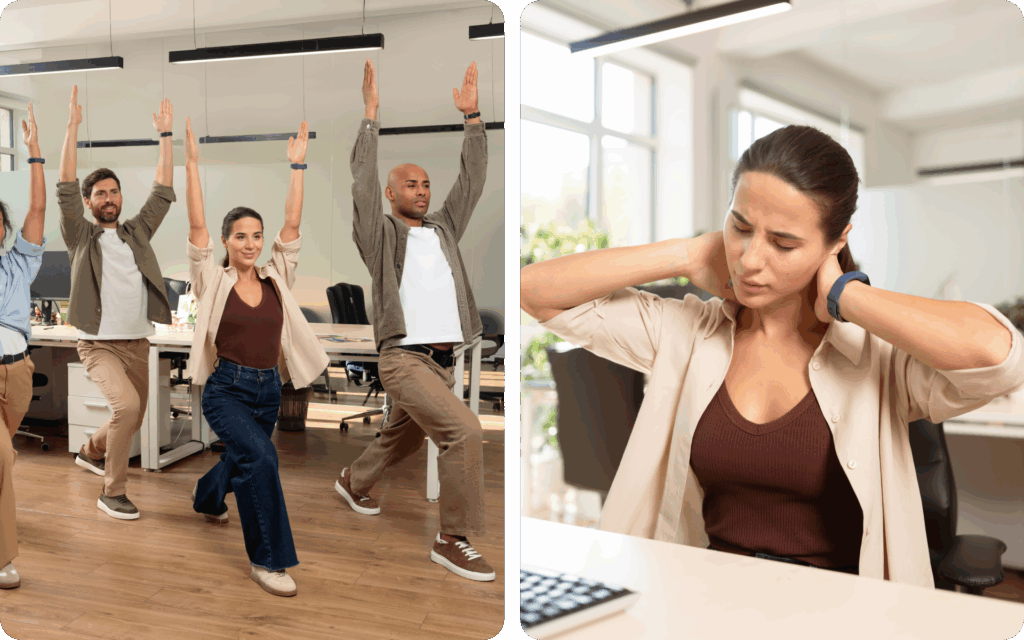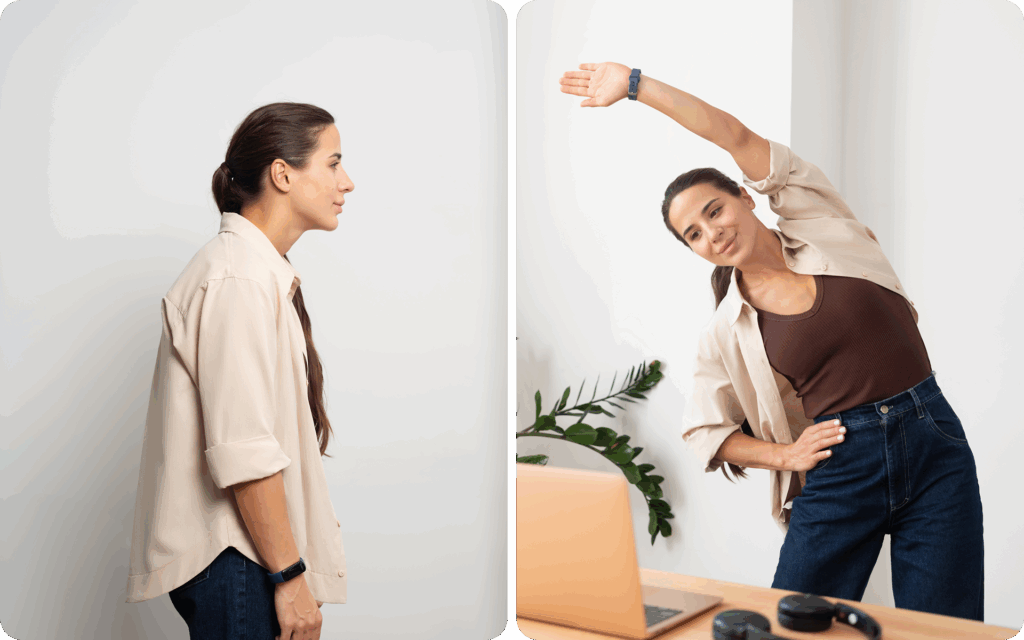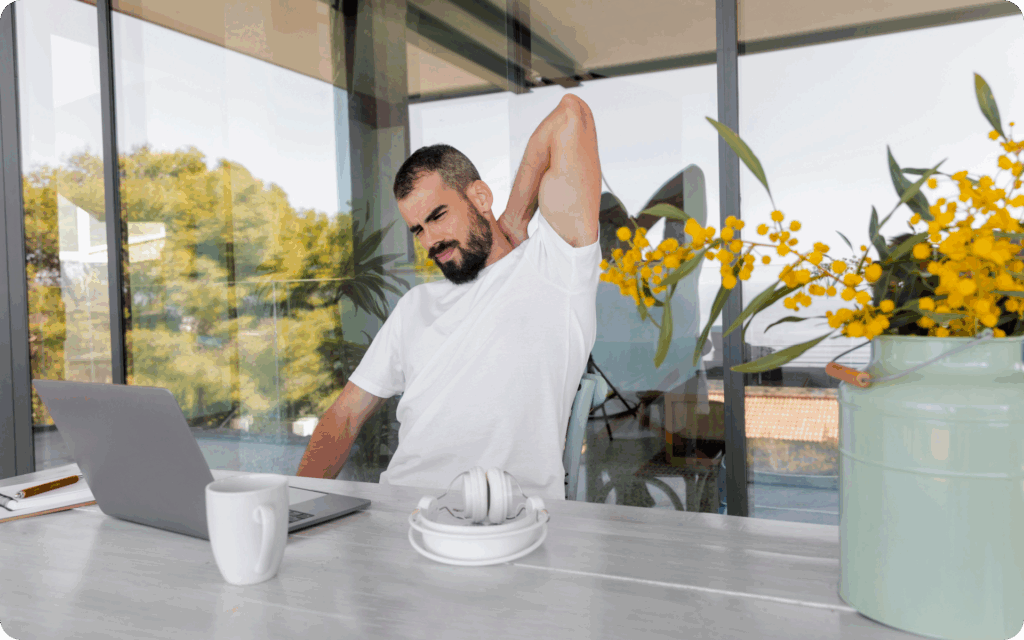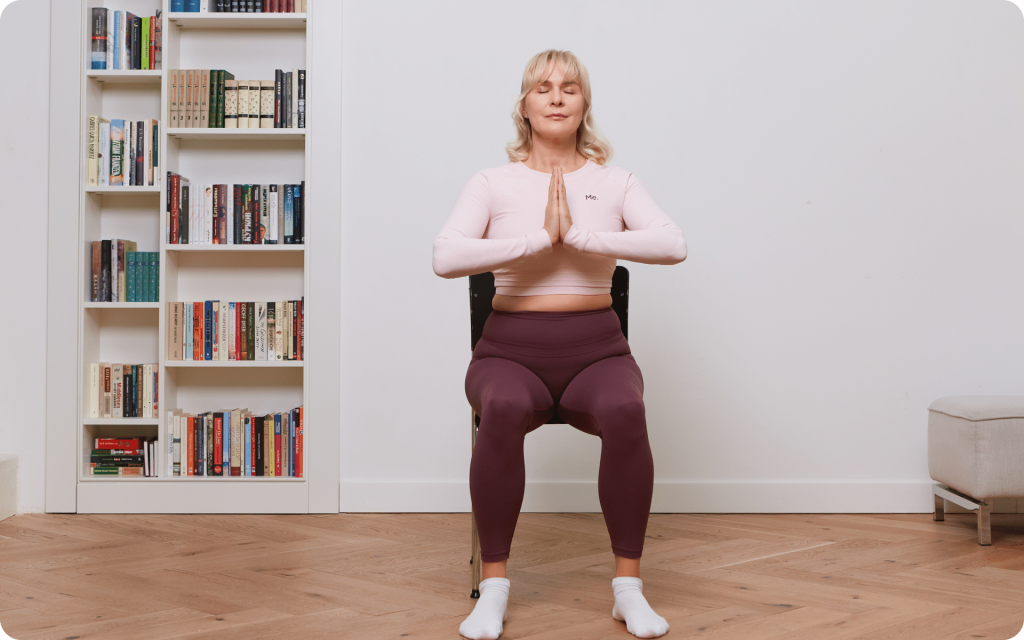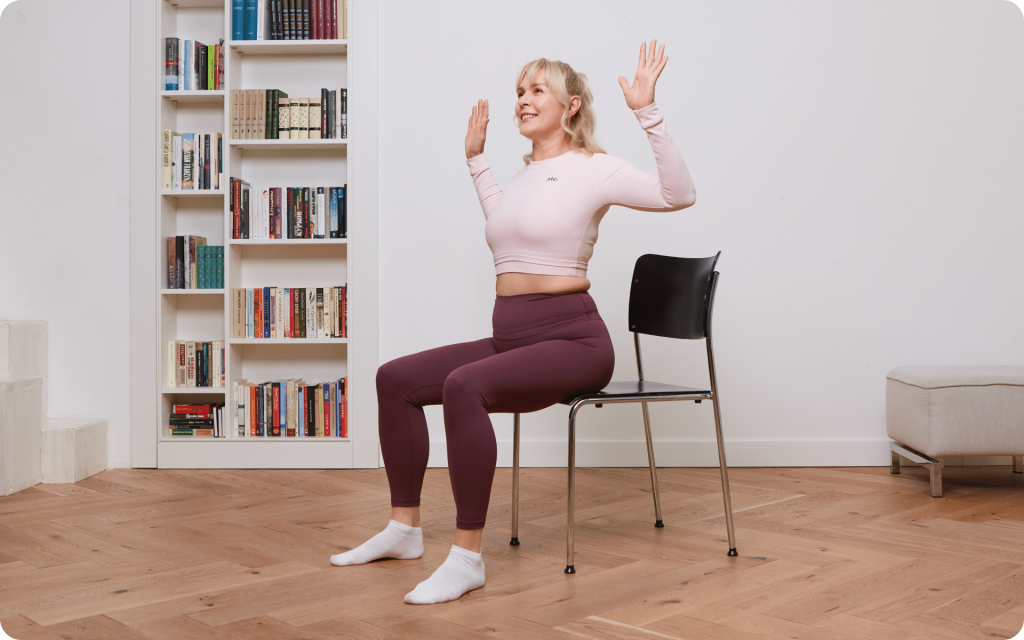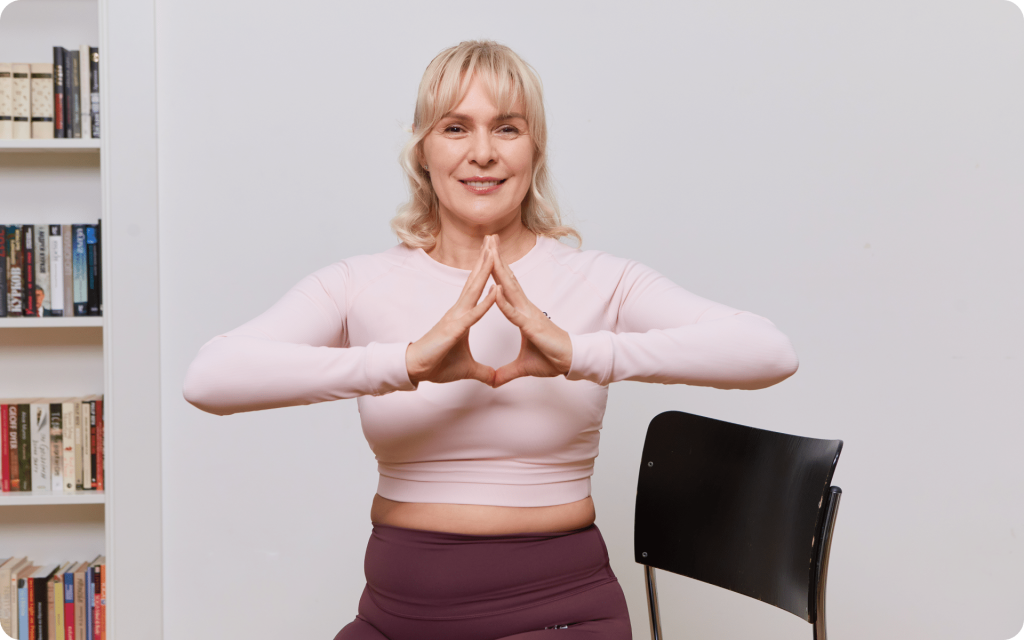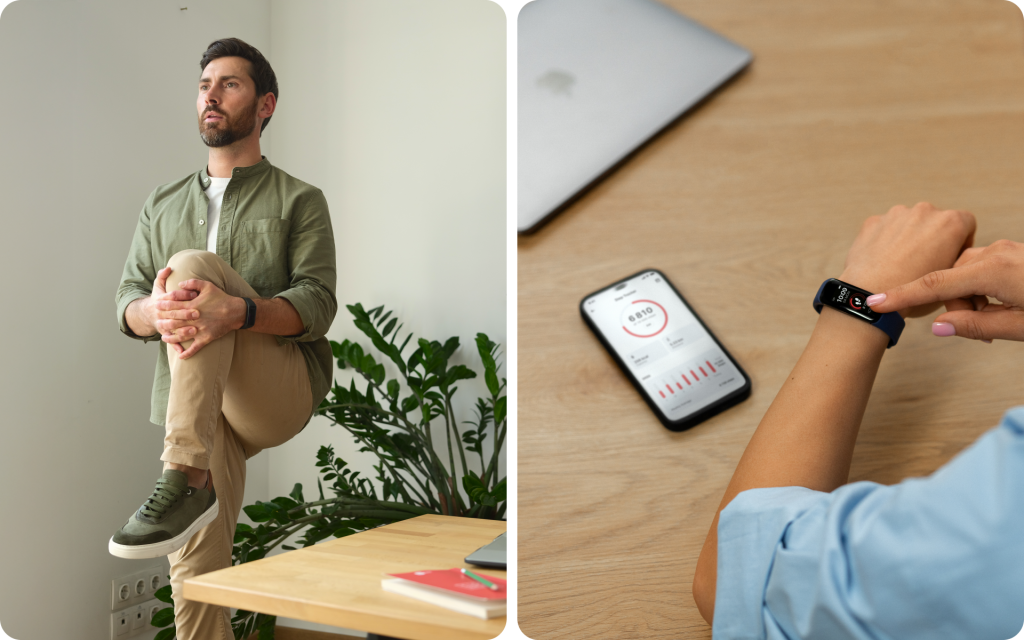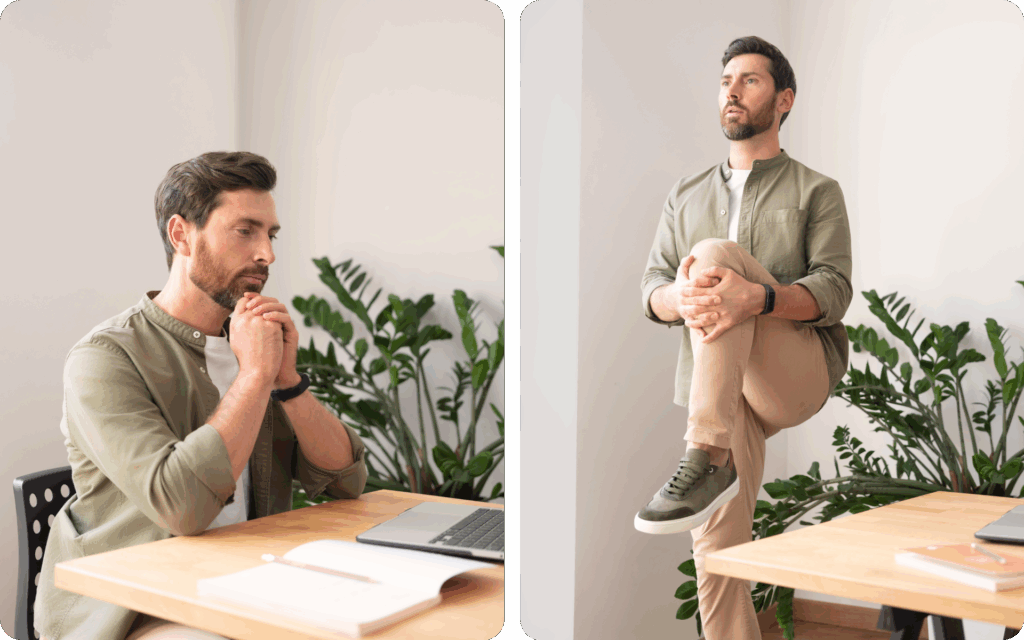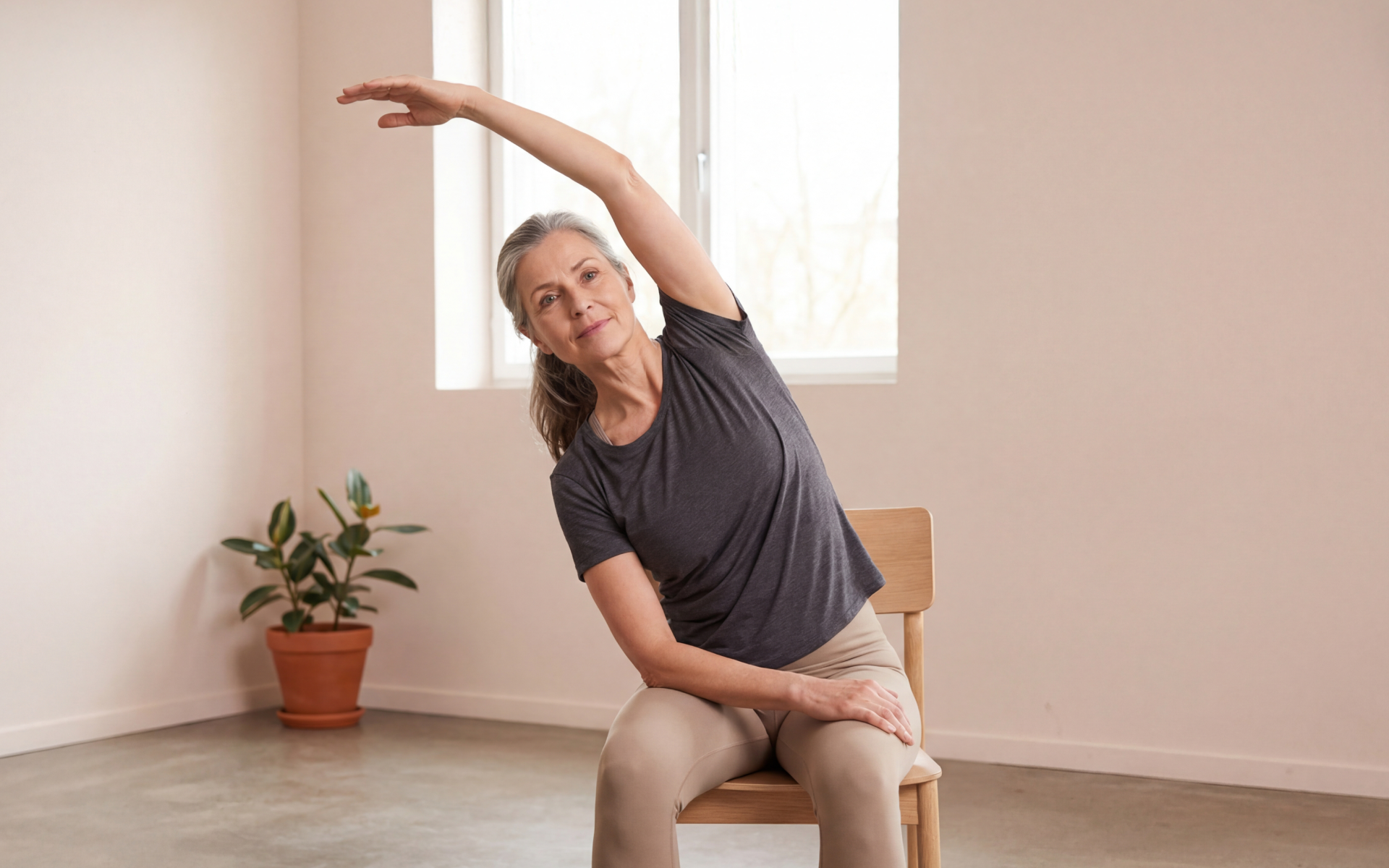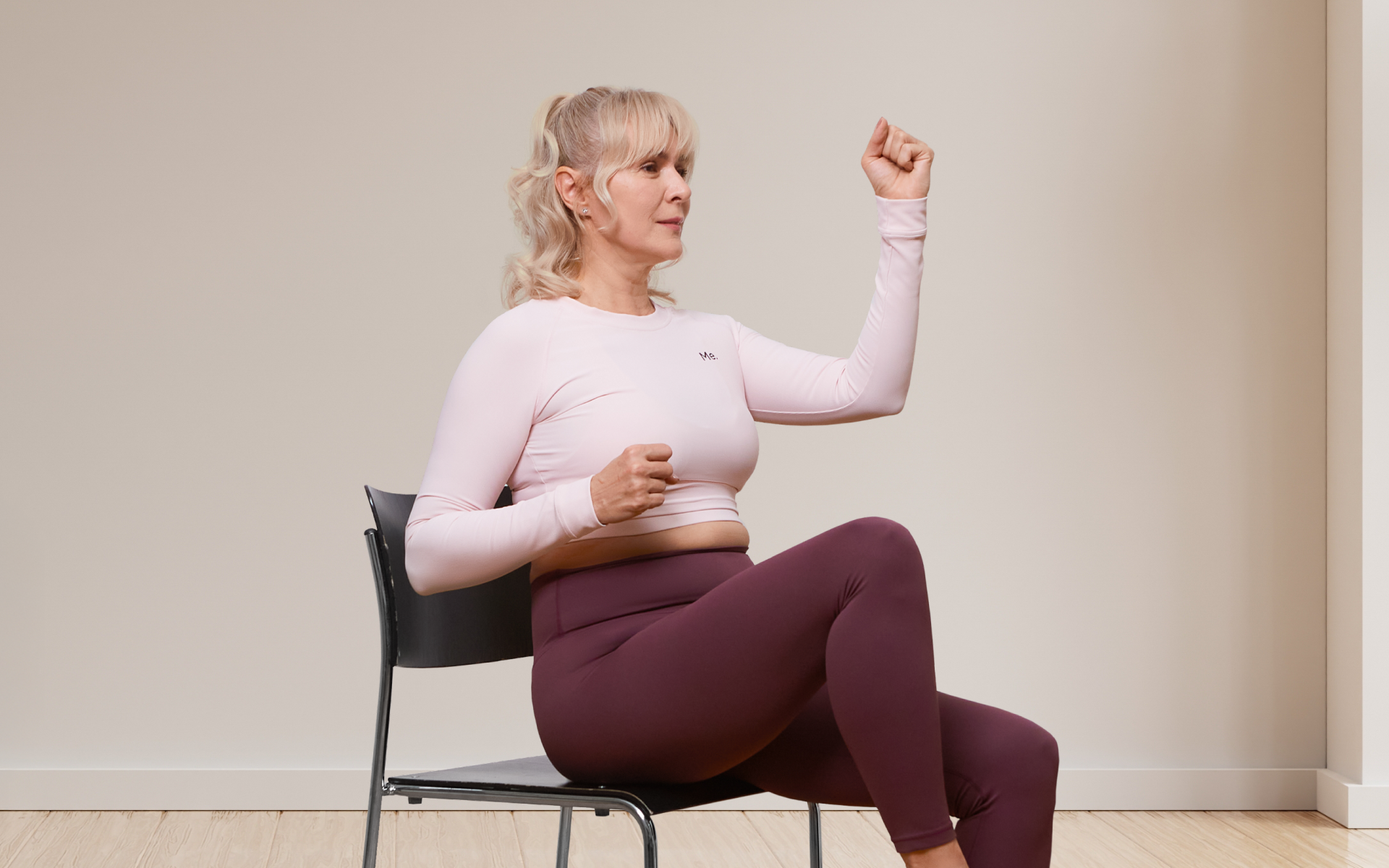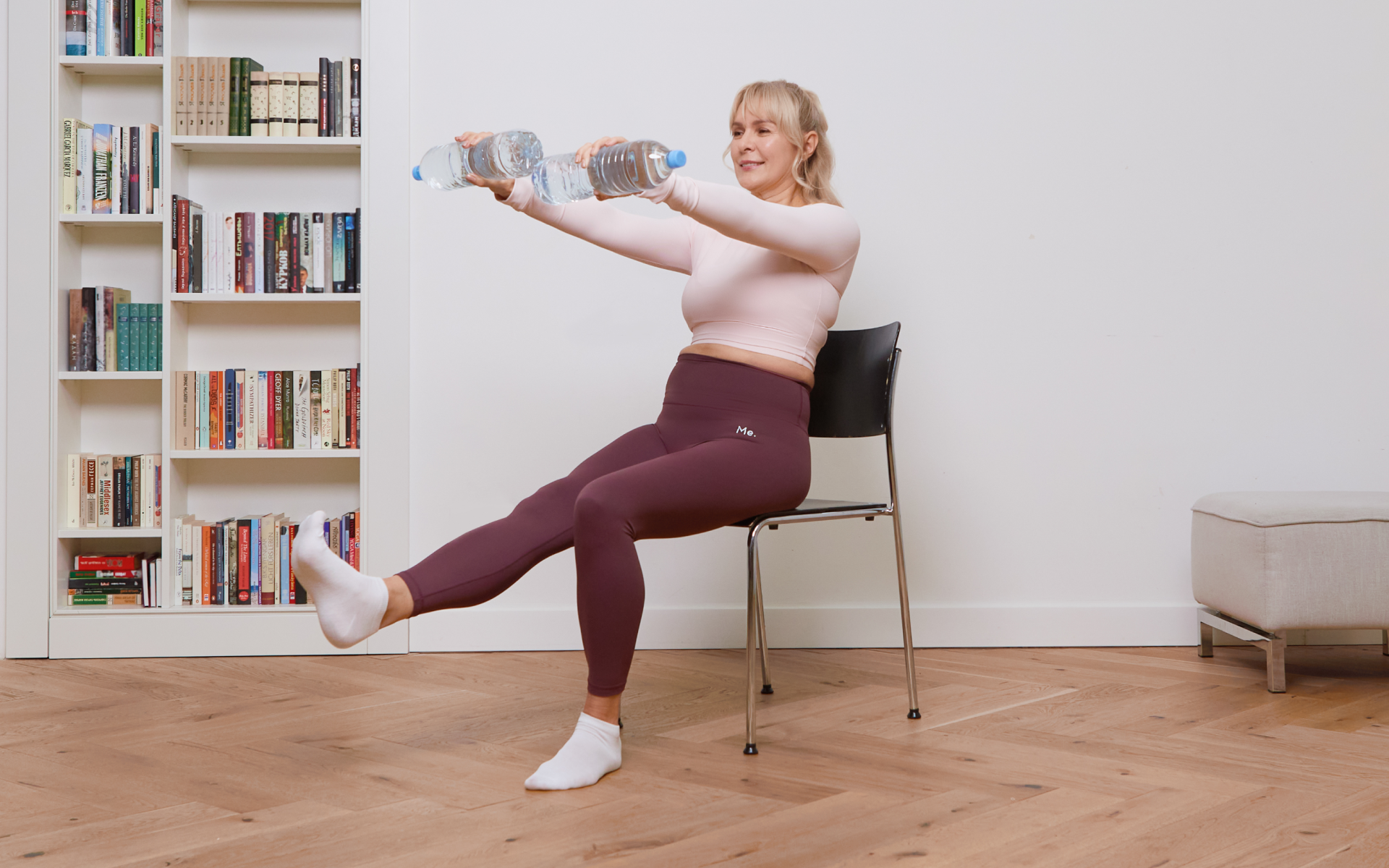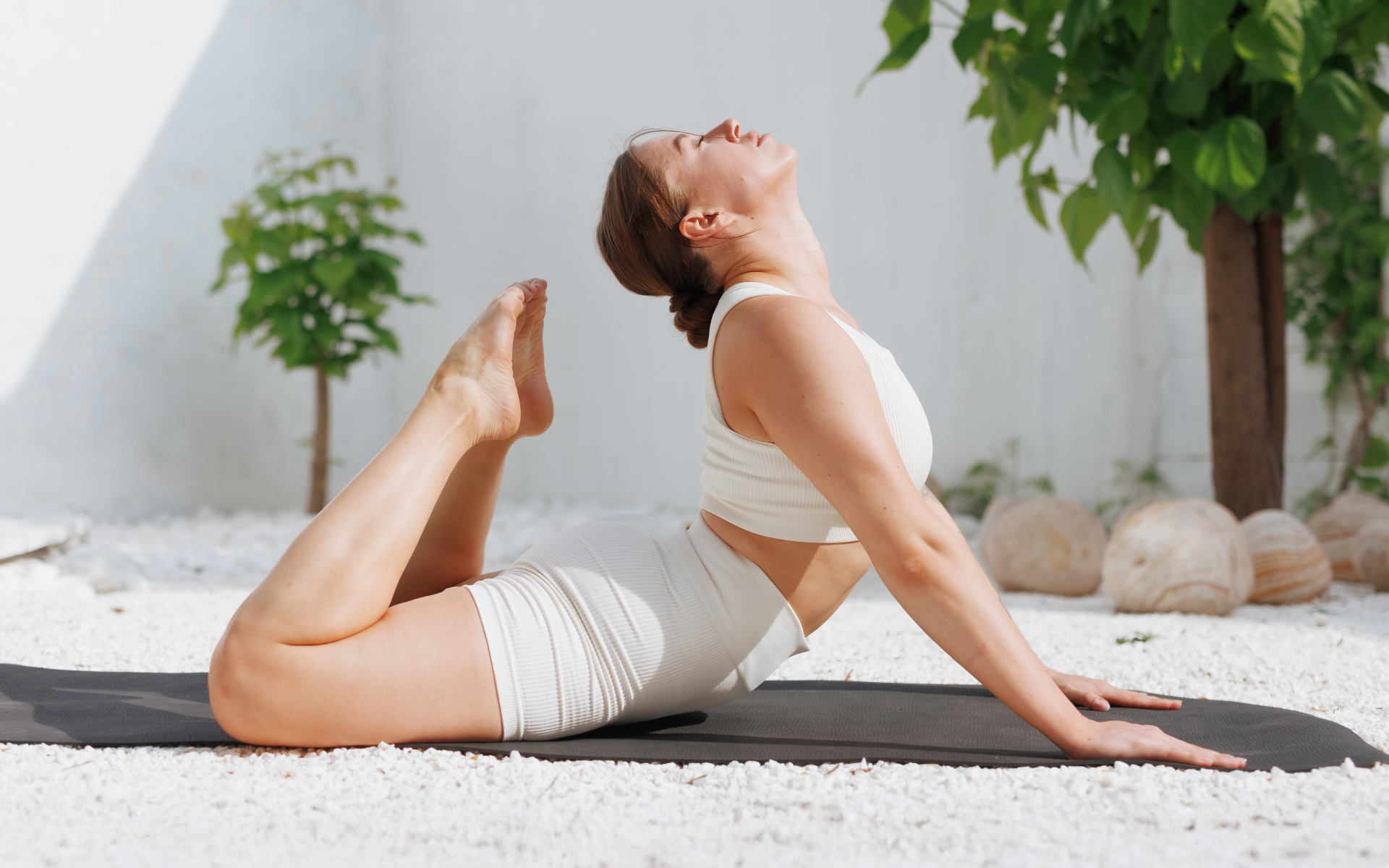Office workers spend an average of 10 hours per day seated, creating a perfect storm of tight hips, rounded shoulders, and chronic back pain. This sedentary lifestyle doesn’t just affect your posture; it impacts your energy, focus, and long-term health.
The adverse effects have many workers asking, “What is discreet desk yoga?”
This practice of desk yoga offers a practical solution that requires no special equipment, minimal space, and anyone can do it without drawing attention from colleagues.
These gentle movements counteract the physical stress of prolonged sitting while providing mental clarity and stress relief.
This guide presents 9 beginner-friendly desk yoga poses that you can seamlessly integrate into your workday. Each pose targets specific areas affected by desk work, from releasing neck tension to improving spinal mobility.
Are Desk Exercises Effective?
Recent research on postural variation reveals compelling evidence for the effectiveness of workplace movement interventions.
A 2023 study published in the Journal of Manipulative and Physiological Therapeutics found that employees who performed brief postural changes every 30 minutes per hour experienced a reduction in neck, shoulder, upper, and lower back discomfort compared to those who remained static (1).
The concept of “postural variation” emphasizes that the human body thrives in movement, rather than in prolonged static positions. When we maintain the same posture for extended periods, specific muscle groups become overactive while others weaken, creating muscular imbalances.
Research published in Frontiers in Physiology demonstrates that even brief micro-movements (lasting just 2-3 minutes) can significantly improve circulation and reduce muscle tension (2). These findings support the effectiveness of desk-based exercises as legitimate interventions for workplace wellness. These desk exercises are similar to chair yoga beginners routines.
Read more: Desk Yoga Poses That Melt Away Stress In Minutes
What Are Some Benefits Of A Desk Yoga Routine?
- Reduces Physical Discomfort
Desk yoga directly addresses the primary physical complaints of office workers.
The gentle stretching movements help lengthen shortened hip flexors, release tight chest muscles, and strengthen weakened posterior chain muscles.
Studies show that yoga practice can reduce neck pain and lower back pain within a few weeks of consistent practice (3).
BetterMe: Health Coaching app helps you achieve your body goals with ease and efficiency by helping to choose proper meal plans and effective workouts. Start using our app and you will see good results in a short time.
- Improves Mental Focus And Clarity
The breathing techniques integrated into desk yoga poses activate the parasympathetic nervous system, which promotes a state of calm alertness. This neurological shift enhances cognitive function and decision-making abilities (4).
Research published in the Frontiers in Psychology indicates that mindful movement practices increase production of brain-derived neurotrophic factor (BDNF), a protein that supports neural growth and cognitive performance (5).
- Enhances Energy Levels
Unlike caffeine-induced energy spikes that lead to crashes, yoga provides sustained energy through improved circulation and oxygenation. The gentle movements stimulate blood flow to the brain and major muscle groups (6).
Research suggests that even short sessions of desk yoga (such as daily 10-minute chair yoga) can help office workers feel more energized, less tense, and better able to focus compared to those who remain sedentary (7, 8).
- Supports Stress Management
Desk yoga incorporates mindful breathing and gentle movement, both proven stress-reduction techniques. The practice helps regulate cortisol levels and promotes the release of endorphins (7, 9).
Clinical research demonstrates that regular yoga practice reduces workplace stress and improves overall job satisfaction (7).
- Promotes Better Posture
The strengthening and lengthening effects of desk yoga poses help correct standard postural deviations associated with desk work.
Regular practice can reduce forward head posture by up to 15 degrees within a 24-week yoga training program (10).
How To Do Desk Yoga Without Leaving Your Office Chair?
Choose Strategic Timing
Practice desk yoga during natural breaks in your workflow.
Ideal times include before meetings, during phone calls where you’re listening, or between major tasks. This approach maintains productivity while incorporating beneficial movement.
Keep Movements Subtle
Focus on poses performed within the confines of your chair and immediate desk space.
Avoid dramatic arm movements or positions that require standing if discretion is a priority.
Use Your Breath as a Guide
Deep, controlled breathing is the foundation of effective desk yoga.
Even when movements are minimal, conscious breathing provides significant benefits for stress reduction and mental clarity (4).
Start Small and Build Gradually
Begin with 2-3 poses performed once daily.
As the movements become habitual, the frequency can gradually increase to every few hours. This progressive approach ensures sustainability without overwhelming your schedule.
Maintain Professional Appearance
Select poses that don’t require removing shoes, loosening clothing, or creating visible changes in your appearance. The goal is wellness that seamlessly integrates with professional responsibilities.
Read more: 10 Chair Yoga Poses For Beginners
What Are Some Beginner-Friendly Desk Yoga Exercises?
Desk yoga for beginners can incorporate the following exercises:
Chair Mountain Pose (Tadasana)
Chair Mountain Pose establishes proper spinal alignment and serves as the foundation for all other desk yoga poses. This position activates core stabilizing muscles and promotes awareness of postural habits.
- Sit with feet flat on the floor, knees hip-width apart.
- Rest your back against the chair or sit tall if the chair allows
- Place hands on thighs with palms facing down.
- Lengthen the crown of your head toward the ceiling.
- Draw shoulder blades down and back.
- Breathe deeply for 30-60 seconds, focusing on spinal extension.
Chair Neck Rolls
Neck rolls help address the forward head posture commonly present in desk workers and release tension in the cervical spine. This movement improves the range of motion and reduces headache frequency.
- Begin in Chair Mountain Pose with shoulders relaxed.
- Slowly drop your right ear toward your right shoulder.
- Gently roll your head forward, bringing your chin toward your chest.
- Continue rolling to the left side, left ear toward left shoulder.
- Roll back to the center and reverse the direction.
- Complete 3-5 slow, controlled circles in each direction
- End in neutral head position
Chair Seated Twists (Parivrtta Tadasana)
Seated twists improve spinal mobility and stimulate digestion while strengthening the core muscles that support proper posture.
- Sit tall in Chair Mountain Pose.
- Place your right hand on the outside of your left thigh.
- Rest your left hand on the back of your chair.
- Inhale to lengthen your spine.
- Exhale while gently rotating your torso to the left
- Keep both hips facing forward throughout the twist.
- Hold for 15-30 seconds, breathing normally.
- Return to the center and repeat on the opposite side.
Chair Cat Cow Pose
This spinal mobility exercise counteracts the rounded posture of desk work by promoting flexion and extension throughout the vertebral column.
- Sit forward in your chair with feet flat on the floor.
- Place hands on knees or thighs.
- Inhale, arch your back, and lift your chest (Cow)
- Draw shoulder blades together and gaze slightly upward.
- Exhale, round your spine, and drop your head (like a Cat).
- Draw your belly button toward your spine.
- Continue alternating between these positions for 5-8 breaths.
Seated Cactus Arms
Cactus arms open the chest and strengthen the muscles between the shoulder blades, directly counteracting rounded shoulder posture.
- Begin in Chair Mountain Pose
- Raise your arms to shoulder height.
- Bend elbows to 90 degrees, creating a “cactus” shape.
- Draw the shoulder blades together and down.
- Press your elbows back gently as you lift your chest.
- Hold for 15-30 seconds while breathing deeply.
- Feel the stretch across your chest and front shoulders.
Chair Flexing Foot Pose
This ankle mobility exercise improves circulation in the lower legs and prevents blood pooling that occurs during prolonged sitting.
- Remain seated with both feet initially flat on the floor.
- Lift your right foot 2-3 inches off the ground.
- Flex your foot firmly, pulling toes toward your shin.
- Point your foot, with your toes extended away from your body.
- Make slow circles with your ankle, 5 times in each direction.
- Lower the right foot and repeat the sequence with the left foot.
- Finish with both feet flat and wiggle toes within shoes.
Hands To Chest Chair
This pose opens the chest and strengthens posterior deltoids while providing a gentle backbend to counter forward posture.
- Sit tall with arms at your sides.
- Bring palms together at the center of your chest in the prayer position.
- Keep elbows wide and parallel to the floor.
- Press palms firmly together while lifting the chest.
- Breathe deeply, feeling expansion across your chest.
- Hold for 20-30 seconds.
- Release arms to your sides with control.
Three Part Breath Chair
This breathing technique activates the parasympathetic nervous system and provides immediate stress relief while improving focus.
- Sit comfortably with one hand on your chest, one on your belly.
- Inhale slowly, expanding your belly first (part one).
- Continue inhaling, expanding your ribcage laterally (part two).
- Complete breath by lifting your chest slightly (part three).
- Exhale in reverse order: chest, ribs, belly.
- Make each phase equal in length and smooth.
- Practice for 5-10 complete breath cycles.
Reasons why BetterMe is a safe bet: a wide range of calorie-blasting workouts, finger-licking recipes, 24/7 support, challenges that’ll keep you on your best game, and that just scratches the surface! Start using our app and watch the magic happen.
Ujjayi Breath
Ujjayi breathing creates internal heat and promotes mental clarity through controlled, audible breathing that most can practice discreetly.
- Sit in Chair Mountain Pose with your lips closed.
- Breathe through the nose only throughout the practice.
- On exhale, gently constrict your throat to create a soft “ocean” sound.
- Maintain the same gentle constriction on inhale.
- Keep jaw relaxed and tongue soft.
- Breathe at a natural pace, focusing on sound quality.
- Continue for 2-3 minutes or as long as comfortable.
What Happens If I Do 10 Minutes Of Desk Yoga Everyday?
Practicing 10 minutes of desk yoga daily creates measurable improvements in both physical comfort and mental performance. Based on workplace wellness research, you can expect to notice initial desk yoga benefits within the first week of consistent practice. The positive effects below can answer the question, “How effective is chair yoga?” Moreover, desk yoga and chair yoga are very similar as they both involve using a chair to stretch.
What to expect when practicing daily 10 minutes of desk yoga:
Week 1-2: Immediate Relief
Most practitioners experience reduced muscle tension and improved energy levels within days. The gentle movements stimulate blood flow and help counteract the stiffness that accumulates during prolonged periods of sitting.
Research indicates that even short-duration movement breaks can reduce perceived muscle tension immediately following the practice session (11).
Week 3-4: Postural Improvements
Consistent practice begins to address deeper postural imbalances. The strengthening and lengthening effects of the poses start to create lasting changes in muscle activation patterns.
Studies show that 4 weeks of regular desk yoga can improve forward head posture by an average of 8 degrees and reduce rounded shoulder measurements by 12% (10).
Month 2-3: Sustained Benefits
Long-term practitioners report improved stress management, better sleep quality, and enhanced job satisfaction. The nervous system adaptations from regular breathing practice contribute to these broader wellness improvements (12).
Clinical data suggest that 8-12 weeks of consistent practice provides the most significant and lasting benefits for workplace wellness (13).
It’s important to maintain realistic expectations. While desk yoga provides meaningful benefits, it’s not a complete solution for severe postural problems or chronic pain conditions that may require professional treatment.
Can Desk Yoga Change Your Body?
“Yoga at desk” workouts can create modest but meaningful physical changes, particularly in areas directly affected by prolonged sitting. However, it’s essential to understand both the potential and limitations of this practice.
- Realistic Physical Changes
Regular desk- or office-compatible yoga routines (performed a few times per week over 6–12 weeks) can significantly improve flexibility in areas commonly tight from seated desk work, such as the hips, spine, neck, and chest.
Depending on the target muscle groups and the specificity of the practice, range-of-motion gains of roughly 10% or more are realistic (14).
In comparison, some studies have demonstrated improvements ranging from 25% to over 50% in trunk or neck flexibility (15).
The strengthening component primarily affects postural muscles and core stabilizers.
While these changes improve function and appearance, they’re not equivalent to comprehensive strength training programs.
- Limitations to Consider
Desk yoga operates within the constraints of office furniture and professional settings.
The movements are necessarily gentle and limited in scope compared to chair yoga, mat yoga classes or comprehensive exercise programs.
For significant body composition changes, weight loss, or major strength gains, desk yoga should supplement rather than replace dedicated exercise time outside of work.
- Measurable Improvements
Research consistently shows that workplace movement interventions like desk yoga can reduce pain levels, discomfort, and burnout significantly (16).
These changes, although modest, have a significant impact on daily comfort and long-term health.
The most realistic expectation is improved function, reduced discomfort, and better movement quality rather than dramatic physical transformation.
Yoga and walking can provide substantial health benefits, but may not meet all fitness requirements for optimal health. The American Heart Association recommends 150 minutes of moderate-intensity aerobic activity weekly (17), which walking can fulfill. However, comprehensive fitness also requires resistance training 2-3 times per week to maintain muscle mass and bone density (17). While yoga provides some strength benefits, it may not provide sufficient resistance for all muscle groups. For complete fitness, consider adding bodyweight exercises or weight training to supplement yoga and walking routines. Poor desk posture typically includes forward head position (where ears align ahead of shoulders), rounded shoulders, increased upper back curvature, and anterior pelvic tilt. This positioning places excessive stress on cervical vertebrae, thoracic spine, and supporting musculature. Specific measurements indicate poor posture when the head projects more than 2 inches forward of the shoulders, shoulder height differs by more than 0.5 inches, or when the natural lumbar curve is lost (18). These postural deviations increase pressure on spinal discs by up to 60% and contribute to chronic pain patterns affecting 54% of office workers (19). Yoga can provide cardiovascular, strength, flexibility, and balance benefits, making it a comprehensive form of exercise for many individuals. However, certain styles of yoga may not adequately address all components of fitness. For cardiovascular health, power yoga or vinyasa styles can elevate heart rate to 60-85% of maximum, meeting aerobic exercise guidelines (20). However, gentle or restorative yoga styles may not provide sufficient cardiovascular stimulus. Further, most yoga practices lack the progressive resistance necessary for optimal muscle and bone strength development. Adults over 30 lose 3-5% of muscle mass per decade without resistance training (21). This muscle loss factor is why it’s essential to include resistance training at least twice a week. Research on circadian rhythms suggests that flexibility and core body temperature peak in late afternoon (4-6 PM), potentially making this the optimal time for yoga practice from a physiological standpoint (22). However, morning yoga practice (6-8 AM) can help establish consistent routines and provide energy for the day ahead. Morning cortisol levels are naturally higher (23), which may enhance the stress-reducing benefits of yoga practice (24). Evening practice (6-8 PM) can aid in stress relief and prepare the body for sleep, but vigorous yoga within 3 hours of bedtime may interfere with sleep quality for some individuals (25). The best time for yoga is whenever you can practice consistently, as regularity provides greater benefits than timing optimization.Frequently Asked Questions
Is yoga and walking enough exercise?
What is poor desk posture?
Can yoga be your only exercise?
Is yoga better in the morning or evening?
The Bottom Line
Desk yoga represents a practical bridge between the demands of modern work life and the human need for movement. These 9 poses offer a scientifically supported approach to counteracting the physical and mental stress of prolonged sitting.
The beauty of desk yoga lies in its accessibility.
You don’t need special clothing, equipment, or a dedicated space. These movements can be seamlessly woven into your existing work routine, providing cumulative benefits that compound over time.
Start with 1-2 poses that address your most pressing concerns, whether it’s neck pain, tight hips, or simply a mental break from intense focus. Then, as you feel comfortable and see results, gradually incorporate more poses into your daily practice.
DISCLAIMER:
This article is intended for general informational purposes only and does not serve to address individual circumstances. It is not a substitute for professional advice or help and should not be relied on for making any kind of decision-making. Any action taken as a direct or indirect result of the information in this article is entirely at your own risk and is your sole responsibility.
BetterMe, its content staff, and its medical advisors accept no responsibility for inaccuracies, errors, misstatements, inconsistencies, or omissions and specifically disclaim any liability, loss or risk, personal, professional or otherwise, which may be incurred as a consequence, directly or indirectly, of the use and/or application of any content.
You should always seek the advice of your physician or other qualified health provider with any questions you may have regarding a medical condition or your specific situation. Never disregard professional medical advice or delay seeking it because of BetterMe content. If you suspect or think you may have a medical emergency, call your doctor.
SOURCES:
- Effects of Postural Shifting Frequency on Perceived Musculoskeletal Discomfort During 1-Hour Sitting in Office Workers (2023, sciencedirect.com)
- Microvascular Adaptations to Muscle Stretch: Findings From Animals and the Elderly (2022, frontiersin.org)
- Effectiveness and safety of yoga to treat chronic and acute pain: a rapid review of systematic reviews (2019, bmjopen.bmj.com)
- How Breath-Control Can Change Your Life: A Systematic Review on Psycho-Physiological Correlates of Slow Breathing (2018, frontiersin.org)
- The Effect of Mindfulness-Based Intervention on Brain-Derived Neurotrophic Factor (BDNF): A Systematic Review and Meta-Analysis of Controlled Trials (2020, frontiersin.org)
- The Effects of Fast and Slow Yoga Breathing on Cerebral and Central Hemodynamics (2020, journals.lww.com)
- Fifteen Minutes of Chair-Based Yoga Postures or Guided Meditation Performed in the Office Can Elicit a Relaxation Response (2012, pmc.ncbi.nlm.nih.gov)
- Impact of 10-Min Daily Yoga Exercises on Physical and Mental Discomfort of Home-Office Workers During COVID-19 (2021, journals.sagepub.com)
- Effects of a chair-yoga exercises on stress hormone levels, daily life activities, falls and physical fitness in institutionalized older adults (2016, sciencedirect.com)
- Yoga Improves Upper-Extremity Function and Scapular Posturing in Persons with Hyperkyphosis (2012, pmc.ncbi.nlm.nih.gov)
- Effect of active breaks on stress and musculoskeletal discomfort during work in office workers (2025, link.springer.com)
- Yoga for improving quality of life in contractual university teachers (2024, frontiersin.org)
- Effect of Chair Yoga Therapy on Functional Fitness and Daily Life Activities among Older Female Adults with Knee Osteoarthritis in Taiwan: A Quasi-Experimental Study (2022, mdpi.com)
- The effect of a Hatha Yoga practice on hamstring flexibility (2021, pubmed.ncbi.nlm.nih.gov)
- Age related differences of selected Hatha yoga practices on anthropometric characteristics, muscular strength and flexibility of healthy individuals (2015, journals.lww.com)
- Randomized controlled trial investigating the role of yoga at workplace in improving fatigue, burnout, pain, strength, and quality of life among blue-collar workers (2024, pmc.ncbi.nlm.nih.gov)
- American Heart Association Recommendations for Physical Activity in Adults and Kids (2024, heart.org)
- Differences in upper body posture between patients with lumbar spine syndrome and healthy individuals under the consideration of sex, age and BMI (2024, occup-med.biomedcentral.com)
- Seat Pressure Distribution Characteristics During 1 Hour Sitting in Office Workers With and Without Chronic Low Back Pain (2017, sciencedirect.com)
- Heart rate and thermal responses to power yoga (2018, sciencedirect.com)
- The age-related loss of skeletal muscle mass and function: Measurement and physiology of muscle fibre atrophy and muscle fibre loss in humans (2018, pmc.ncbi.nlm.nih.gov)
- The effects of time of day and chronotype on cognitive and physical performance in healthy volunteers (2018, sportsmedicine-open.springeropen.com)
- The Cortisol Awakening Response in Context (2010, sciencedirect.com)
- Yoga, mindfulness-based stress reduction and stress-related physiological measures: A meta-analysis (2017, sciencedirect.com)
- Effects of exercise timing and intensity on physiological circadian rhythm and sleep quality: a systematic review (2023, pubmed.ncbi.nlm.nih.gov)
